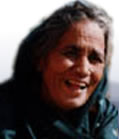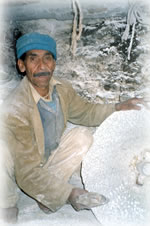 |
 |
||
 |
|||
|
RELATED THEMES education employment and income migration OTHER LOCAL THEMES BACKGROUND |
traditional skills
The majority of narrators say traditional skills are now in decline, and some stress the need to revive them, and bring back employment as well as craftmanship. Loss of resources is one of the reasons for decline - for example, less cotton is grown now, so weaving and spinning cloth has decreased; deforestation has affected the carpentry trade; and the reduction in biodiversity has affected those practicing herbal medicine. New agricultural methods have also had an impact: reliance on modern seeds and inputs is rendering obsolete some of women's skill in preserving seeds and storing crops in special vessels with natural pesticides. This is one of the areas currently undergoing revival, with the Save the Traditional Seeds movement. Education has had some impact too, as people, especially from lower castes, opt for waged work instead of continuing with their caste occupation. For example, several mention that young people from the caste traditionally associated with musical instruments, playing for wedding parties etc, prefer not to do this, in order to distance themselves from their caste status: "There were Aujis in the village who played instruments, they have taken to some other work and left their traditional work. Now people.prefer to pick up new work in order to feel more advanced. Will this lead us to development?" (India 32) Another (India 28) says: "People are aping what is called 'modern'. The blacksmith thinks that his profession is useless and he should switch over to some other job. Today the mason feels that the old style and patterns are useless and wants to construct something new." Most people, though, clearly took pride in the old self-sufficiency and many express regret that they rely so much more on mass-produced products now; a few confess that they prefer plastic buckets, factory-made shoes and clothes made from brightly coloured, synthetic materials. There is still a market for traditional goods; a few people talk about selling their products to outsiders, especially woollen items. A Jaad narrator (India 25), who still practises seasonal migration, says "We spin wool, make pankhis (shawls) carpets, sweaters and. choda (made of goat's wool) which is a thick carpet-like material for sitting. We make woollen material for coats in a variety of colours and checks. We make material of any pattern desired. This is the main source of income for our people. The spinning wheel goes along with us - up and down [the mountains]." It is clear that a significant number of narrators are actively trying to support the revival of the old crafts and skills, but in a modern context. quotes about traditional skills"Handicrafts have declined in this area. They were very popular in old days, but as people get educated they go outside for service and for other business purposes. Cottage crafts have become less important. But some [of] the old generation are still busy in making small articles like baskets and mats from bamboo. They do it as they did it in the past. Some people also rear sheep and spin the wool on the spinning wheel. This type of spinning and weaving work is still in fashion." "All the traditional work like pottery, carpentry and other occupations like blacksmiths, goldsmiths and oilmen should be revived.We were very happy in the past. Now we are in great trouble. Blacksmiths have given up their jobs. Now we depend on those who came from outside for a short period and live in temporary sheds beside the roads. Potters were also found here, but today earthen pots are not available. Other trades have also gradually become extinct." "There are roots and herbs [which make natural dyes], but people buy colours from the market. These new colours are bright whereas our natural colours are a little dull. That is why people have stopped using them." "Today it is as if houses are made overnight. Earlier the carvings would take years. The carving was done of thuner (yew). Today, wood is not available, and even if we have wood lying on our own land, then the forest officer comes to arrest us, and asks us why the wood is lying here and from where have we obtained it.To get wood from the forest officer is extremely difficult. We have to first give him money.if this is not done then how is one to carve [wood]?.thus carving [has become an expensive art] and slowly is disappearing." |
|
 It is clear from the interviews that most communities were largely self-sufficient and made skilled use of the resources around them. As well as different castes specialising in particular crafts such as metalworking, shoemaking, pottery, carpentry and weaving, some individuals developed specialist knowledge in areas such as traditional medicine, and most ordinary people also employed a range of skills to make household items such as baskets and their own clothes, and to process and store food. India 8 says:
It is clear from the interviews that most communities were largely self-sufficient and made skilled use of the resources around them. As well as different castes specialising in particular crafts such as metalworking, shoemaking, pottery, carpentry and weaving, some individuals developed specialist knowledge in areas such as traditional medicine, and most ordinary people also employed a range of skills to make household items such as baskets and their own clothes, and to process and store food. India 8 says: